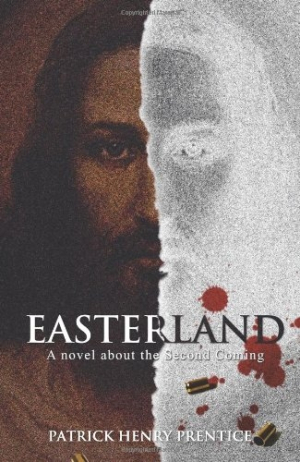Easterland
A Novel about the Second Coming
The new Messiah is born (via in vitro fertilization) in this intriguing and skillfully rendered sci-fi novel.
“I went on a fool’s errand. A hornet stung me in the eye … I was given some insight into the way the universe works.” That’s how Dr. Bishop explains the colossal mess he’s made after being asked by an angel to create a new Messiah in his laboratory. Easterland is the first novel by veteran television writer Patrick Henry Prentice, who offers a bizarre but credible contemporary slant on the Biblical story of Jesus of Nazareth.
“Doc” Bishop, a scientist by trade and a Catholic at heart, shuns the natural method of conception as unsuited to the Biblical task he’s been assigned and instead impregnates a young virgin through a mysterious form of in vitro fertilization utilizing DNA from the Shroud of Turin (“a first year biochemistry major could have done it”). Receiving word from above that his first trial might have gone wrong, he tries again, resulting in two prospective contenders for the title of Christ, genetic twins Peter and Paul. One is born to great celebration and expectation, the other to disappointment and resentment.
The twins’ destinies cross when televangelist Billy Tarr sees the face of a new Christ during a dream about the end of days. While making an unscheduled stop in the southwest desert (on Ash Wednesday), Billy immediately recognizes the setting of his prescient dream and is moved to start Easterland, the largest tent revival in televised history, right on the spot. Will Peter and Paul meet there and initiate Armageddon?
Created by an author who acknowledges having written science fiction for pulp magazines “in a previous incarnation,” Easterland is sci-fi for the religiously minded (believers and scoffers). The narrative jumps back and forth between the upbringings and early adulthoods of mankind’s two possible saviors, raised in radically different circumstances. Each chapter is told from a distinct character’s viewpoint, but the changes do not jar; in Prentice’s practiced hands the overall thrust of the story remains dominant. Because of the many issues that stream through it, the novel provokes thought but avoids getting bogged down in religious or sociological pondering.
One note of concern, however, is nonstandard punctuation, as quotation marks are not used with dialogue. While most of the time dialogue is separated from narrative, occasional snippets pop up in a paragraph: “He had poured the champagne into two laboratory vials and said, To the angel.” This questionable convention can hinder comprehension in what is an otherwise compelling read.
The front cover art has a professional look, with its divided face—a hint of a ghostly visage from The Shroud on one side, and a man with classic Jesus features on the other. This echoes the story’s theme: how can we recognize the true Christ?
Any readers not immediately turned away by the subject matter (through an excess of piety or cynicism) will find Easterland to be a fast-paced novel with an intellectual backbeat. Prentice realistically dissects in a modern context the salient elements of the New Testament story of the Messiah and examines how expectations, or the lack thereof, impact human destiny.
Reviewed by
Barbara Bamberger Scott
Disclosure: This article is not an endorsement, but a review. The publisher of this book provided free copies of the book and paid a small fee to have their book reviewed by a professional reviewer. Foreword Reviews and Clarion Reviews make no guarantee that the publisher will receive a positive review. Foreword Magazine, Inc. is disclosing this in accordance with the Federal Trade Commission’s 16 CFR, Part 255.

